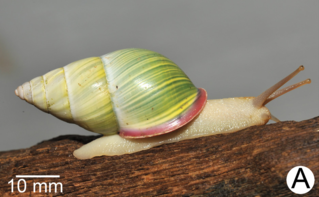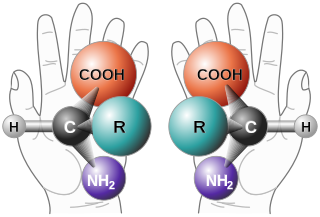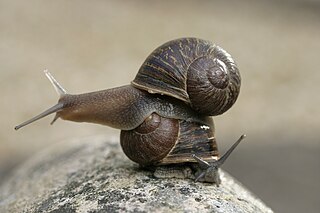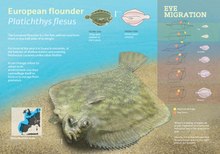
Body relative directions are geometrical orientations relative to a body such as a human person's body or a road sign. The most common ones are: left and right; forward and backward; up and down. They form three pairs of orthogonal axes.

A mirror image is a reflected duplication of an object that appears almost identical, but is reversed in the direction perpendicular to the mirror surface. As an optical effect, it results from specular reflection off from surfaces of lustrous materials, especially a mirror or water. It is also a concept in geometry and can be used as a conceptualization process for 3D structures.

Asymmetry is the absence of, or a violation of, symmetry. Symmetry is an important property of both physical and abstract systems and it may be displayed in precise terms or in more aesthetic terms. The absence of or violation of symmetry that are either expected or desired can have important consequences for a system.

Symmetry in biology refers to the symmetry observed in organisms, including plants, animals, fungi, and bacteria. External symmetry can be easily seen by just looking at an organism. For example, the face of a human being has a plane of symmetry down its centre, or a pine cone displays a clear symmetrical spiral pattern. Internal features can also show symmetry, for example the tubes in the human body which are cylindrical and have several planes of symmetry.
Handedness is a human attribute reflecting the unequal distribution of fine motor skill between the left and right hands.
Left and right or left–right may refer to:

Dakshinavarti shankha, also referred to as Valampuri shankhu and Sri Lakshmi shankha is a sacred Hindu conch. It refers to the shell of a large sea snail from the Indian Ocean, but one that has a rare reverse-turning spiral.

In structural geology, vergence refers to the direction of the overturned component of an asymmetric fold. In simpler terms, vergence can be described as the horizontal direction in which the upper component of rotation is directed. Vergence can be observed and recorded in folds to help a geologist determine characteristics of larger fold areas. Vergence is used to provide an overall characterization, in the symmetry of folds, and can be used to observe changes in small-scale structures in relation to the axis of a large fold. The vergence of a fold lies parallel to the surrounding surfaces of a fold, so if these surrounding surfaces are not horizontal, the vergence of the fold will be inclined. For a fold, the direction and the extent to which vergence occurs can be calculated from the strike and dip of the axial surfaces, along with that of the enveloping surfaces. These calculations can be handy for geologists in determining the overall elements of larger areas.

The gastropod shell is part of the body of many gastropods, including snails, a kind of mollusc. The shell is an exoskeleton, which protects from predators, mechanical damage, and dehydration, but also serves for muscle attachment and calcium storage. Some gastropods appear shell-less (slugs) but may have a remnant within the mantle, or in some cases the shell is reduced such that the body cannot be retracted within it (semi-slug). Some snails also possess an operculum that seals the opening of the shell, known as the aperture, which provides further protection. The study of mollusc shells is known as conchology. The biological study of gastropods, and other molluscs in general, is malacology. Shell morphology terms vary by species group.

Amphidromus is a genus of tropical air-breathing land snails, terrestrial pulmonate gastropod mollusks in the family Camaenidae. The shells of Amphidromus are relatively large, from 25 mm (0.98 in) to 75 mm (3.0 in) in maximum dimension, and particularly colorful. During the 18th century, they were among the first Indonesian land snail shells brought to Europe by travelers and explorers. Since then, the genus has been extensively studied: several comprehensive monographs and catalogs were authored by naturalists and zoologists during the time period from the early 19th to the mid 20th centuries. Modern studies have focused on better understanding the evolutionary relationships within the group, as well as solving taxonomic problems.

Turbinella pyrum, common names the chank shell, sacred chank or chank, also known as the divine conch or referred to simply as a conch, is a species of very large sea snail with a gill and an operculum, a marine gastropod mollusk in the family Turbinellidae. This species occurs in the Indian Ocean.

The term chiral describes an object, especially a molecule, which has or produces a non-superposable mirror image of itself. In chemistry, such a molecule is called an enantiomer or is said to exhibit chirality or enantiomerism. The term "chiral" comes from the Greek word for the human hand, which itself exhibits such non-superimposeability of the left hand precisely over the right. Due to the opposition of the fingers and thumbs, no matter how the two hands are oriented, it is impossible for both hands to exactly coincide. Helices, chiral characteristics (properties), chiral media, order, and symmetry all relate to the concept of left- and right-handedness.

Two-dimensional rotation can occur in two possible directions or senses of rotation. Clockwise motion proceeds in the same direction as a clock's hands relative to the observer: from the top to the right, then down and then to the left, and back up to the top. The opposite sense of rotation or revolution is anticlockwise (ACW) or counterclockwise (CCW). Three-dimensional rotation can have similarly defined senses when considering the corresponding angular velocity vector.

Amphidromus perversus is a species of air-breathing land snail, a terrestrial pulmonate gastropod mollusc in the family Camaenidae.

Port and starboard are nautical terms for watercraft, aircraft and spacecraft, referring respectively to the left and right sides of the vessel, when aboard and facing the bow (front).

Chirality is a property of asymmetry important in several branches of science. The word chirality is derived from the Greek χείρ (kheir), "hand", a familiar chiral object.
Ayna is a monotypic genus of air-breathing land snails, terrestrial gastropod mollusks in the family Enidae. The sole species in the genus is Ayna mienisi. It was described as Zebrina (Ramusculus) mienisi. The genus Ramusculus however is a monotypic genus only distantly related to Ayna. The closest relative of Ayna is probably Clausilioides.

Jeremy was a left-coiled garden snail studied by researchers from the University of Nottingham.
In developmental biology, left-right asymmetry is the process in early embryonic development that breaks the normal symmetry in the bilateral embryo. In vertebrates, left-right asymmetry is established early in development at a structure called the left-right organizer and leads to activation of different signalling pathways on the left and right of the embryo. This in turn causes several organs in adults to develop LR asymmetry, such as the tilt of the heart, the different number of lung lobes on each side of the body, and the position of the stomach and spleen on the right side of the body. If this process does not occur correctly in humans it can result in heterotaxy or situs inversus.
















